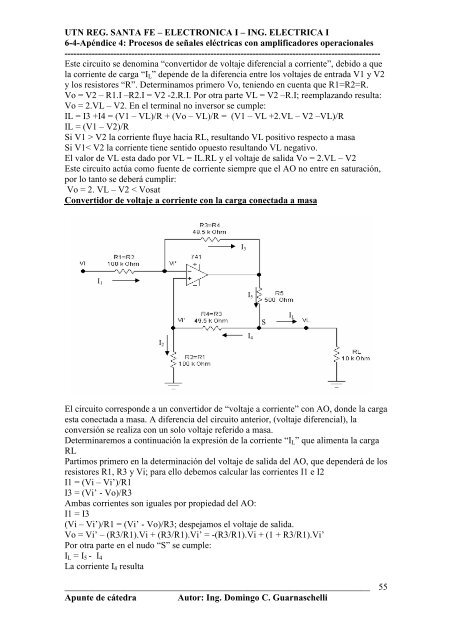6-4Procesos_de_señales_electricas_con_amplificadores_operacionales-1
Create successful ePaper yourself
Turn your PDF publications into a flip-book with our unique Google optimized e-Paper software.
UTN REG. SANTA FE – ELECTRONICA I – ING. ELECTRICA I<br />
6-4-Apéndice 4: Procesos <strong>de</strong> <strong>señales</strong> eléctricas <strong>con</strong> <strong>amplificadores</strong> <strong>operacionales</strong><br />
--------------------------------------------------------------------------------------------------------<br />
Este circuito se <strong>de</strong>nomina “<strong>con</strong>vertidor <strong>de</strong> voltaje diferencial a corriente”, <strong>de</strong>bido a que<br />
la corriente <strong>de</strong> carga “I L ” <strong>de</strong>pen<strong>de</strong> <strong>de</strong> la diferencia entre los voltajes <strong>de</strong> entrada V1 y V2<br />
y los resistores “R”. Determinamos primero Vo, teniendo en cuenta que R1=R2=R.<br />
Vo = V2 – R1.I –R2.I = V2 -2.R.I. Por otra parte VL = V2 –R.I; reemplazando resulta:<br />
Vo = 2.VL – V2. En el terminal no inversor se cumple:<br />
IL = I3 +I4 = (V1 – VL)/R + (Vo – VL)/R = (V1 – VL +2.VL – V2 –VL)/R<br />
IL = (V1 – V2)/R<br />
Si V1 > V2 la corriente fluye hacia RL, resultando VL positivo respecto a masa<br />
Si V1< V2 la corriente tiene sentido opuesto resultando VL negativo.<br />
El valor <strong>de</strong> VL esta dado por VL = IL.RL y el voltaje <strong>de</strong> salida Vo = 2.VL – V2<br />
Este circuito actúa como fuente <strong>de</strong> corriente siempre que el AO no entre en saturación,<br />
por lo tanto se <strong>de</strong>berá cumplir:<br />
Vo = 2. VL – V2 < Vosat<br />
Convertidor <strong>de</strong> voltaje a corriente <strong>con</strong> la carga <strong>con</strong>ectada a masa<br />
I 1<br />
I 3<br />
I 5<br />
S<br />
I L<br />
I 2<br />
I 4<br />
El circuito correspon<strong>de</strong> a un <strong>con</strong>vertidor <strong>de</strong> “voltaje a corriente” <strong>con</strong> AO, don<strong>de</strong> la carga<br />
esta <strong>con</strong>ectada a masa. A diferencia <strong>de</strong>l circuito anterior, (voltaje diferencial), la<br />
<strong>con</strong>versión se realiza <strong>con</strong> un solo voltaje referido a masa.<br />
Determinaremos a <strong>con</strong>tinuación la expresión <strong>de</strong> la corriente “I L ” que alimenta la carga<br />
RL<br />
Partimos primero en la <strong>de</strong>terminación <strong>de</strong>l voltaje <strong>de</strong> salida <strong>de</strong>l AO, que <strong>de</strong>pen<strong>de</strong>rá <strong>de</strong> los<br />
resistores R1, R3 y Vi; para ello <strong>de</strong>bemos calcular las corrientes I1 e I2<br />
I1 = (Vi – Vi’)/R1<br />
I3 = (Vi’ - Vo)/R3<br />
Ambas corrientes son iguales por propiedad <strong>de</strong>l AO:<br />
I1 = I3<br />
(Vi – Vi’)/R1 = (Vi’ - Vo)/R3; <strong>de</strong>spejamos el voltaje <strong>de</strong> salida.<br />
Vo = Vi’ – (R3/R1).Vi + (R3/R1).Vi’ = -(R3/R1).Vi + (1 + R3/R1).Vi’<br />
Por otra parte en el nudo “S” se cumple:<br />
I L = I 5 - I 4<br />
La corriente I 4 resulta<br />
___________________________________________________________________<br />
Apunte <strong>de</strong> cátedra Autor: Ing. Domingo C. Guarnaschelli<br />
55



